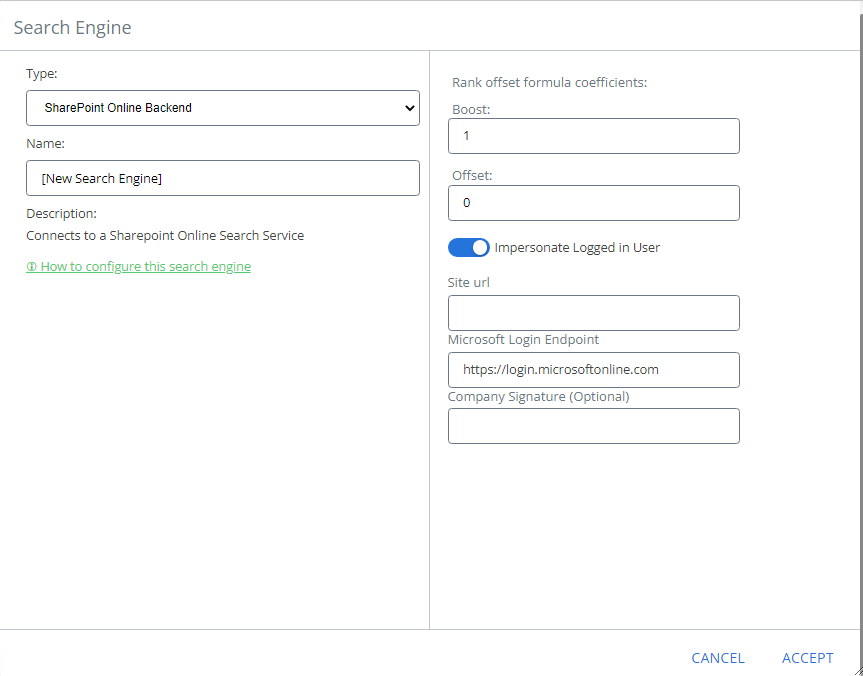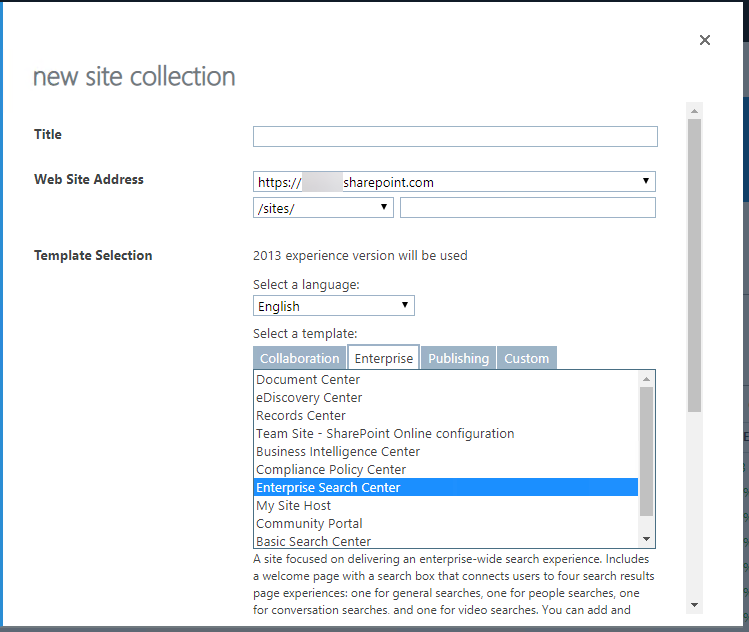Connect SmartHub to the SharePoint Online Search Engine
Use the following procedure to connect SmartHub to your SharePoint Online search engine.
REQUIRED
When using SharePoint Online as your search engine, only Azure Active Directory can be used to secure SmartHub and authenticate users.
How to Configure the SharePoint Online Search Engine
- Navigate to the SmartHub Administration page at:
http(s)://[web-app-url]/_admin
- Click General Settings > ADD NEW SEARCH ENGINE. The Search Engine window below displays.

- Name (required): Enter a unique name for your search engine. This name cannot be duplicated and can contain only letters, digits, or any of the following characters:
- ' ', '-', '_', '.', '(', ')', '[', ']'
- ' ', '-', '_', '.', '(', ')', '[', ']'
- Type: Select Regular.
- Search Engine: Select SharePoint Online.
- Rank offset formula coefficients (optional): These values are used only if you selected the Rank Based mixing algorithm that is set in the Properties for SmartHub SSA page. For more information, see Specify the Mixing Algorithm.
- BOOST: Enter the boost factor.
- OFFSET: Enter the rank offset.
- These are the tokens used to access the site collection:
- Site url: Enter the URL for your SharePoint Online Search Center, which is a site collection created with a SharePoint "Enterprise Search Center" template. You may receive an error when performing a query if you do not use a Search Center URL in this field.

- Access Token: Enter the access token from SmartHub's OAuth page.
- Refresh Token: Enter the refresh token from SmartHub's OAuth page.
- Client Id: Enter the Application ID from Azure App Registrations.
- Client Secret: Enter the Key's value from Azure App Registrations.
- Company Signature (Optional): Enter the company signature. This is used to avoid getting throttled by SharePoint O365.
- Example: NONISV|Contoso|GovernanceCheck/1.0
- See here for more details on required format.
- Impersonate: Click to let SmartHub assume the identity of the specified account when retrieving data. If impersonation is checked you don't need to fill the rest of fields.
- Site url: Enter the URL for your SharePoint Online Search Center, which is a site collection created with a SharePoint "Enterprise Search Center" template. You may receive an error when performing a query if you do not use a Search Center URL in this field.
- After completing Site Url, Client Id and Client Secret, click Authorize. A new tab will open to log in.
- After logging in, you are redirected to SmartHub's OAuth page where you can find the access token and refresh token. See How to register an app in Azure and configure it.
- Click OK to add this search engine.
How to Register an App in Azure and Configure It
SmartHub with SharePoint Online requires Azure Active Directory authentication. You can register an app in Azure by following the instructions in the sub-topic "Azure Active Directory" in Set Access and User Authentication for SmartHub with SharePoint Online.
How to Show Personal OneDrive Documents
In order to request personal OneDrive documents the ContentSetting property must be configured.
- The OneDrive documents will not be visible but can be found in the query result ResultBlocks attribute.
- Enabling ContentSetting is done using a Query Scripting Processor stage, while manipulating the OneDrive documents is done using a Results Scripting Processor stage.
Examples
Example of how the Query Scripting Processor used to enable the ContentSetting can look like:
if(Query.QueryText.Contains("ContentSettingFlag"))
{
Query.QueryText = Query.QueryText.Replace(" ContentSettingFlag","");
Query.AdditionalPropertiesFromBag = new Dictionary<string,object>();
Query.AdditionalPropertiesFromBag["ContentSetting"] = 3;
}In the example only when the "ContentSettingFlag" keyword is passed to the query text, the ContentSetting property will be enabled. This is done so that the property is enabled only for a specific query. ContentSettingFlag is used only as an example and the query can be identified in other ways too. For example, SourceID.
The ContentSettingFlag was passed to the query text via a ContentBySearch:
<div class="CoveoContentBySearch cbs-tab-container" id="top-results" data-query-text='* FederatorBackends:"*" ContentSettingFlag' data-source-id="b29924a9-ec32-4c10-8892-a544b69ee121" data-results-per-page='3' data-hide-until-first-query="false">An example of how the Results Scripting Processor is used to manipulate the OneDrive personal documents can look like:
if(Results.ResultBlocks.Count > 0)
{
Results.RelevantResults.Clear();
foreach(var resultBlock in Results.ResultBlocks)
{
Results.RelevantResults.AddRange(resultBlock.BlockResults);
}
}In this example the original results will be replaced with the results from the ResultBlock that contains the OneDrive personal documents.
Note: The three results per page is a SharePoint limitation.
While showing more than three results at a time is not possible, the Pager component can be used to show multiple pages.
If the OneDrive documents are shown in a Content-By-Search component the Pager component must also be added to the Content-by-Search.
The Pager component markup: <div class="CoveoPager"></div>